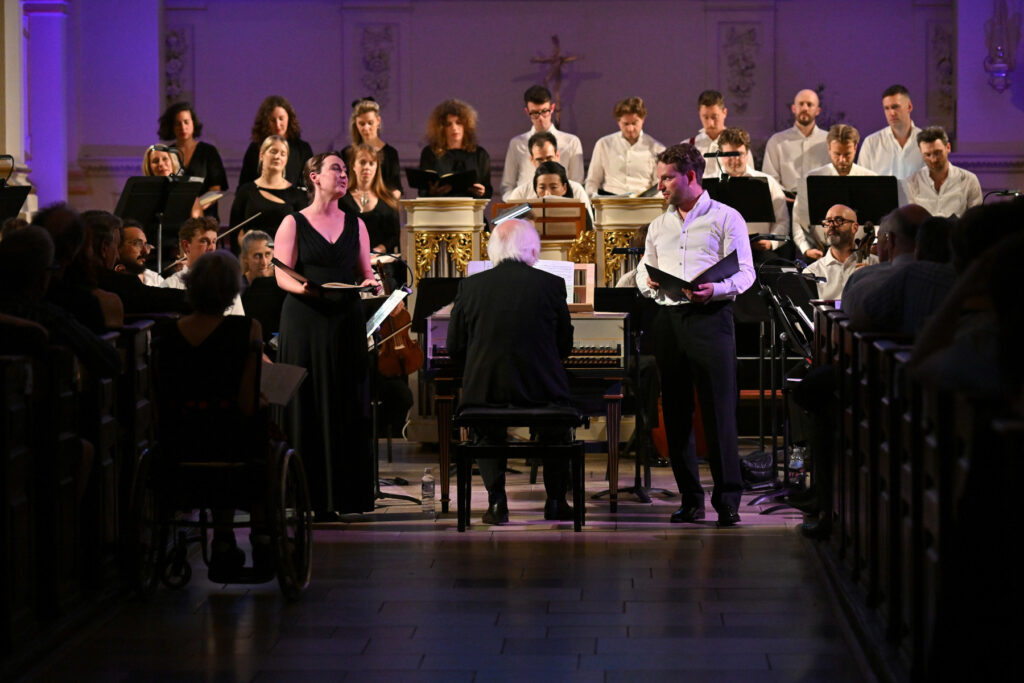Making his debut with the Monteverdi Choir and English Baroque Soloists, Masaaki Suzuki directed an all-Bach concert celebrating the 300th anniversary of five works (four cantatas and a Sinfonia) written in 1725 when the composer was Thomaskantor in Leipzig.
The Monteverdi Choir has, of course, long been associated with its founder Sir John Eliot Gardiner, and both he and Suzuki have recorded a complete cycle of Bach’s sacred cantatas with their respective choirs, Suzuki with the Bach Collegium Japan. Both have done sterling work in showcasing a composer whose cantatas remain only partially appreciated. During Eliot Gardiner’s year-long Bach pilgrimage in 2000, he noted in one cantata-dominated programme at Winchester Cathedral that “only a handful are known or played today”. That may be true in terms of recordings, though live performances of the cantatas in the UK began a century ago with the Newcastle Bach Choir (established in 1915 by W.G Whittaker), the Bach Cantata Club (founded in 1926 by Charles Kennedy Scott) and, from the 1950s, Paul Steinitz who directed the London Bach Society.

That said, Eliot Gardiner’s observation largely remains true, and since Bach produced three cycles of cantatas for every Sunday in the church’s year, it’s hardly surprising many are still unfamiliar. I had only encountered one of the four cantatas performed at St Martin-in-the-Fields; a church being constructed during the same period that Bach was consolidating his achievements and creating a second cycle of cantatas. Those selected by Suzuki brought together three works for performance either side of Easter and a cantata written for the 1st Sunday after Christmas.
His choices uncovered some pearls and some inspirational performances – albeit mostly confined to the soloists and the players. While the members of the chorus brought assurance to Wie schön leuchtet der Morgenstern, BWV 1, diction was not always clear, and Suzuki left little room for dynamic shading, his players (including pairs of horns and oboe di caccia) seemingly unresponsive to the 18 singers behind them. From where I was sitting, the result was more noise than detail, and despite the soprano’s chorale tune soaring overhead, the ‘morning star’ gleamed only intermittently. That all changed with Carolyn Sampson (soprano) and Guy Cutting (tenor) who, together, brought ardour and luminosity to two wonderful arias anticipating the birth of Christ proclaimed by the Angel Gabriel.

From the Feast of the Annunciation, we shifted to Quinquagesima Sunday, or the Sunday before Lent, for Herr Jesu Christ, wahr’ Mensch und Gott, BWV 127, a cantata focusing on the sufferings of Christ. Chief amongst the work’s many delights was the soprano aria ‘Die Seele ruht in Jesu Händen’ sung with exquisite poise by Sampson, its heart-ease supported by delicate elaborations from two recorders and oboe, and tolling bell figuration from pizzicato strings. A bass recitativo and aria gave Matthias Winckhler an opportunity for sonorous expression in a vivid evocation of the Last Judgment, Russell Gilmore’s trumpet adding much to the drama.
After the interval, the ‘Sinfonia’ from Am Abend aber desselbigen Sabbats, BWV 42, delivered life-affirming music written for the first Sunday after Easter, and a rewarding collaboration between strings and a concertante group of two oboes and bassoon. Further jubilation followed in the splendid opening chorus of Ihr werdet weinen und heulen, BWV 103, here enlivened by some virtuosic recorder playing from Tabea Debus who later brought bird-like embellishments to the alto aria, ‘Kein Arzt ist Suber dir zu finden’, where a suitably earnest Rebecca Leggett made entreaties for the healing of our sins by a divine physician. Guy Cutting and trumpeter Russell Gilmore returned to admonish those whose faith was inadequate to believe in the Resurrection, its anticipation implicit from the melismas on ‘Freude’.
The evening concluded with Gottlob! nun geht das Jahr zu Ende, BWV 28, a cantata for the Sunday after Christmas beginning with a spirited soprano aria giving thanks for the previous 12 months. Three trombones and a cornetto added fresh timbres to the ensuing chorus, but its festive manner felt laden with the sheer weight of sound. Further blessings on the year came via an alto and bass duet in which Leggett and Winckhler enjoyed their lively exchanges, anchored by a superbly supportive continuo team.
Overall, these were impressive performances which one would expect from the assembled forces. Had there been crisper diction and more tonal variety from the choir I might have been searching for superlatives. That said, the contributions from the soloists were wonderfully shaped, their words unfailingly invested with meaning.
David Truslove
J.S. Bach: Wie schön leuchtet der Morgenstern, BWV 1; Herr Jesu Christ, wahr’ Mensch und Gott, BWV 127; ‘Sinfonia’ from Am Abend aber desselbigen Sabbats, BWV 42; Ihr werdet weinen und heulen, BWV 103; Gottlob! nun geht das Jahr zu Ende, BWV 28.
Monteverdi Choir; English Baroque Soloists; Carolyn Sampson – soprano; Rebecca Leggett – alto; Guy Cutting – tenor; Matthias Winckhler – bass; Masaaki Suzuki – Conductor
St Martin-in-the-Fields, London; 19 June 2025
Top image: Carolyn Sampson, Monteverdi Choir & English Baroque Soloists, and Masaaki Suzuki
All photos © Mark Allan